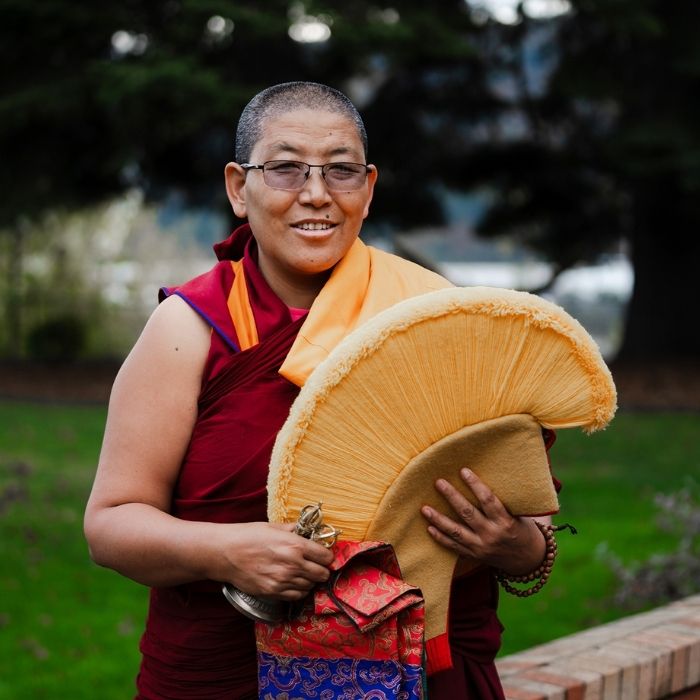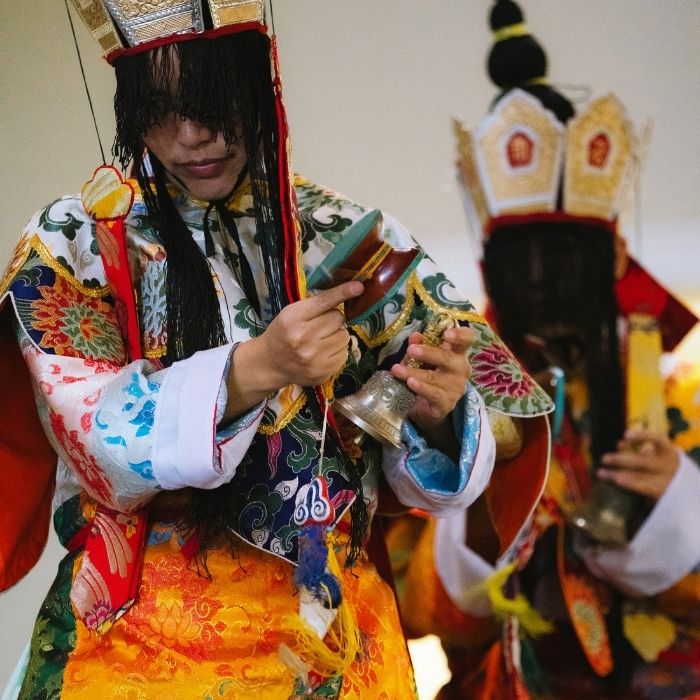WINTER 2025
Cutting Through
Buddhist nuns visited The Bluff, sharing a message of love and compassion.
- Story by Sallie Tisdale

Buddhist nun Geshema Yeshi Sangmo, greeting a visitor who wears the Khata, a scarf given as an offering. Photos by: Megan LaPrelle
YEARS AGO, A teacher challenged me to explain my Buddhist beliefs without using any special vocabulary. I stumbled for a few moments, used to the shorthand a religious community creates for itself. It was a good lesson, because I had to find the words for our common human values in order to share my own.
Recently, I asked the nun Geshema Yeshi Sangmo how she would meet this challenge. We spoke largely through an interpreter, Lobsang Chime, though Yeshi Sangmo speaks a little English. (“Geshema” is the title for a highly accomplished nun in Vajrayana Buddhism, more commonly called Tibetan Buddhism.) She is well-trained in the complicated language of that school, but she had an immediate answer without any need for it.
It is wisdom to develop a bond with one’s student first, she said. “What we need between people is the bond.” Using plain language is an aspect of wisdom. To teach others,“we have to know what others want us to teach.” “Every religion believes in love and compassion,” she said. “We all have differences, which is something we have to accept. But what we all have in common is love and compassion. It should be taught in schools.”
Geshema and three younger nuns from the Jangchub Choeling Education and Welfare Society visited the University of Portland in October. Jangchub Choeling was founded in Mundgod, India, in 1987 in order to provide education and the advanced training in Buddhist study long denied to women. The nunnery now houses 308 nuns from several countries; their ages range from eight to 82 years. The Dalai Lama, head of the Gelug order to which the nunnery belongs, has asked the nuns to become teachers and take the Dharma—Buddhist teaching—to other countries. Their visit to campus was originally the idea of the late Father Claude Pomerleau, CSC, who cherished interreligious exchange. This was their first trip to the United States, and the University was one of their first stops. This tour, which will last for months, was arranged by the Wholistic Peace Institute in West Linn and with the support of Our Lady of the Lake Parish in Lake Oswego.
They’d been enjoying the newness of the scenery, including a day spent hiking at Multnomah Falls.
After we spoke, the nuns took the stage in Bauccio Commons. The three younger women—Venerable Sonam Dolma, Venerable Kunga Tsomo, and Venerable Sherab Dolma—sat cross-legged on their chairs. All wore the traditional burgundy-colored inner robe and bright yellow upper robe wrapped around one shoulder, leaving the right arm bare.
Their way of teaching on the tour is to share several of the religious rites they are trained to perform—rituals which are believed to have powerful reverberations. They began with a Chöd chant. Chöd means “cutting through” or “severing,” and refers to the “afflictions” of greed, hatred, and ignorance. These are considered great poisons. Buddhism teaches that no being is permanent or unchanging, and that nothing is entirely separate from everything else. In Buddhism, ignorance means ignorance of this true nature. This interweaving of all seemingly separate beings into one is a key Buddhist concept, underlying all the teachings about wisdom and how to overcome suffering. Wisdom really begins with the understanding that we are all connected—that in a crucial way, we are one. Earlier that afternoon, I had asked Geshema what she thought about the deep divisions in the world today. Many people seem not to want to find common ground. “Self-centeredness is the root of suffering,” she said. “We don’t know the feeling of putting others before the self. This is joy.”
Chöd singing has many variations; the one they practiced at the University is known as Chöd tsok, which includes a ceremony of offering the self to the world. Geshema asked the audience to meditate on how to eliminate the afflictions in ourselves, and how to release our attachment to our separate identities. Chöd is often done in a group, one of the many forms of intimate witnessing that Buddhist practice encourages.
The four women sat quietly for a few moments while a small audience scattered around the big, cold room waited in silence. When they began to sing, the sound was ethereal and almost monotonal, gradually developing a subtle melodic harmony. Note by note, they added the chime of little bells, then a simple beat from two-handed hand drums called damaru. Each drum head has a large bead hanging from a string, which strike the drum as it is quickly rotated back and forth. The chant grew in strength, becoming more deeply layered, giving nourishment to the compassion and fearlessness we need to release ourselves from the bonds of suffering.

Geshema Yeshi Sangmo, holding the traditional yellow hat of the Gelug sect.

A dakini dancer.
TIBETAN BUDDHISM IS methodical and disciplined, a demanding practice combining precision, complication, faith, and intellect. Geshema studied for seventeen years before she began her examinations—science, calligraphy, debate, poetry, monastic discipline, logic, and Buddhist philosophy. She had to master the Wisdom Sutras, a very long and dense set of teachings about the nature of enlightenment. (There are many men with the title Geshe, but women have been given the rank, signified by the syllable ma, only since 2008. Due to an ancient bureaucratic rule that no one has yet been willing to change, men can reach higher ranks beyond this.) Eventually Geshema passed several rigorous, weeks-long examinations over a period of four years, winning vigorous public debates and memorization challenges as well as passing oral and written tests. She received her degree just days before traveling to the United States.
When I asked about the limitation on degrees for women, she didn’t answer directly, saying, “After this, the thing to do is serve the community.” There will be many more women with her depth of training in the future, she explained. Some will write books or do research; others will teach new students or tour to share with the world, as she is doing. “In order to become a practitioner the one thing that matters is you have to have the wish to help all beings.” Buddhism teaches that we free ourselves in the process.
By touching our connectivity to others, we release our painful separateness. By working to free all beings, we free ourselves. Such connection, of course, can be a challenge as well. I have lived in a cloistered Buddhist community myself, which means living in close quarters with almost no privacy and little free time. In my own lineage in Japanese Soto Zen, we call such an experience “potato practice”—because potatoes kept in a bag together inevitably bang around, rubbing the dirt off each other. I described this to the nuns, and they all laughed; such a smoothing over was familiar.
The nuns at Jangchub Choeling come from Tibet and India, Nepal, and Bhutan, but also from several European countries and the United States.“We try to find the common ground,” she said with a smile. One of the eight auspicious symbols of Vajrayana is known as the glorious endless knot, representing interdependence. “We can’t be separated.”
After the Chöd performance, there was a long intermission while the nuns exchanged musical instruments and then dressed in the elaborate costumes required for dakini dance. Dakini (khandroma in Tibetan) means “sky dweller” or “sky dancer.” Dakini are embodiments of an enlightened feminine force, and serve many roles in the religion’s cosmology. The performance the nuns gave at the University was a dance of gratitude to all the spiritual leaders in the world who are working “for the betterment of all beings.” Geshema, wearing the gold conical hat that symbolizes her vows, stood with one of the nuns in a corner of the stage, playing drum and cymbals. The two other nuns stepped up onto the stage wearing full-length, long-sleeved dresses made of many layers of satin, silk, and brocade in several colors. One of the dancers kept her eyes hidden behind a ropy veil; the other hid her entire face. To a deep melody and with an almost excruciating slowness and grace, the costumed dancers stepped across the stage, turning and turning again, in the synchrony of mythic creatures or characters from a dream.
One of the last questions I was able to ask Geshema Yeshi Sangmo took longer to answer than I expected—though I should not have been surprised. I often work with students who suffer from shame and even self-hatred. The Western emphasis on individuality has drawbacks; our impassioned defense of self-interest feeds competition with each other. People often judge themselves harshly, without any sense of a supporting community.
What did she think of our culture’s emphasis on competition and consumption, which seems to fuel this negativity?
The other Americans in the room were nodding as I spoke, but the nuns looked puzzled. They do not suffer this particular pain.
They held a long conversation, conversing quickly in Tibetan.
Finally Geshema sat up, nodded and smiled and said, “Just put others first and you are okay.”
SALLIE TISDALE ’83 is the author of more than 10 books, most recently Survivor and the Endless Gaze.